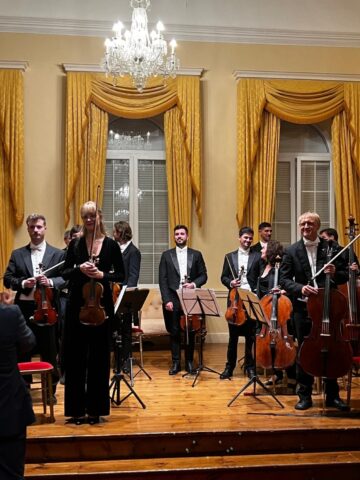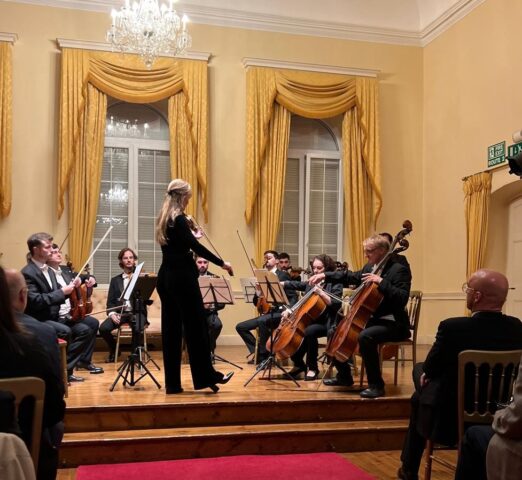Strings Serenade
Photos by Joe Knodt.
By C.Wall
The European Sinfonietta strings, a 13-strong section of the touring orchestra, opened the Philharmonic Society’s season with a cosy though satisfying programme of three popular serenades.
Arranged comfortably in the Convent Ballroom, and free from the difficulty of having to balance the louder orchestral sections, the Sinfonietta strings produced a lush and vibrant sound, led confidently by a collegiate violinist, with a clear sense of what each part should achieve.
Mozart’s teenage Divertimento in F Major K.138 began breezily, at times rather Italian in colour.
The Andante was unabashedly lovely, warm and always on the tasteful side of emotion. The Presto had the air of the dance that follows solemnity, vigorous and life-affirming, without ever relaxing completely.
Continental orchestras don’t perform Elgar too frequently, and his Op. 20 Serenade for Strings was an inspired choice for this audience. The opening viola and cello lilt was handled effectively, and violin divisions added a depth while retaining a broad sweep.
The aching Larghetto seemed very English pastoral, at times recalling a dreamier Enigma Variations, but there was a chamber precision to the strings, even to the percussive effects. The Allegretto retained some of the dreaminess, balanced with a dancelike energy on one side and a wistful melancholy on the other.


Though composed less than two decades before Elgar’s, Dvořák’s Serenade for Strings Op. 22 evokes a very different world, moving away from the Czech folk tunes that made his name, toward the broad sophistication of the Viennese imperial capital.
The opening Moderato carried a filmic sweep with a stately grace. The celebrated Waltz was light and more Romantic, with a tonal switch that felt like a movement break. The Scherzo was appropriately energetic, though not too fast to sacrifice character in the development. The Larghetto was irresistibly languid, slow enough to articulate the beauty of the writing, broad enough to float above sentiment.
The Finale took us back to rural Bohemia, with fast bow strokes evoking the call and response of country dancing, creating a texture of possibility. It didn’t always match the mood established by the rest of the Serenade, but adventure was a welcome replacement for coherence.
The encore, from an “Air on the G String” setting of J S Bach’s BWV 1068, soared celestially. The players showed no little skill in freshening an air made stale by commercial overexposure. The Ministry of Culture, the primary sponsor of the evening, will have appreciated an evening that was calm, accessible and only quietly serious.









